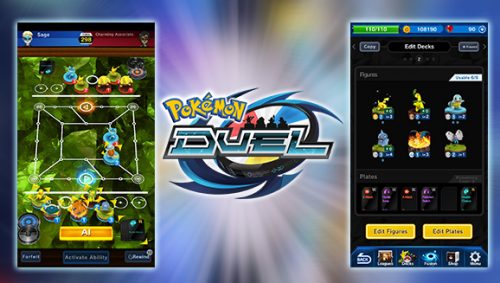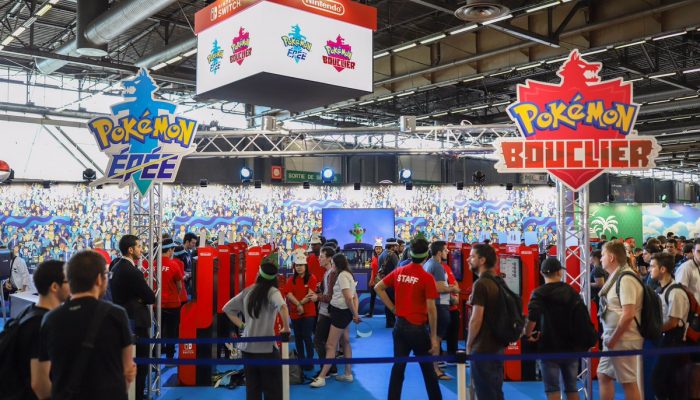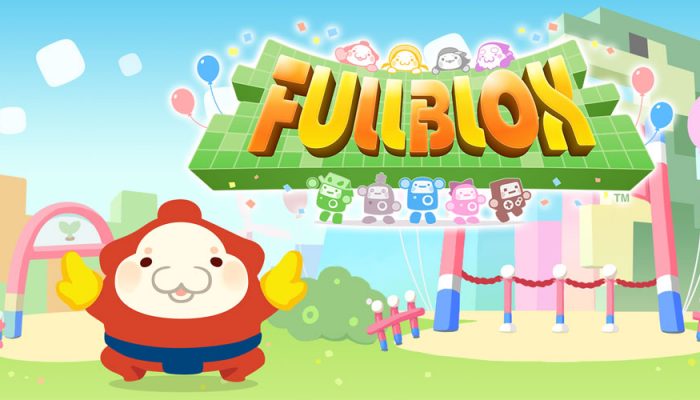 Learn the ropes of the latest Pokémon smartphone game.
Learn the ropes of the latest Pokémon smartphone game.
☆ NintendObs Weekly – Monday, February 13, 2017 – Sunday, February 19, 2017.

Prime Yourself for Pokémon Duels
There’s an exciting new way for Pokémon Trainers to duel! Pokémon Duel uses tactical Pokémon Figure battles to challenge veterans and youngsters alike to a battle of wits. With a deck of Pokémon Figures, augmented by special cards called Plates, you must move your Pokémon Figures across the board to your opponent’s goal or prevent your opponent from moving to claim victory. You’ll need to block your opponent’s Pokémon as they charge your goal, while you think ahead to outmaneuver your foe.
If you’ve already started playing Pokémon Duel but you’re finding some of the functions and features are still eluding you, this may be a useful guide. Pokémon Duel gameplay can be complex, so read on to make sure you’ve got the basics down. And if you haven’t yet started playing the hottest new type of Pokémon competition, keep in mind that Pokémon Duel is free to download for iOS and Android devices. Check out our app page for more information on how you can start playing.
Discover Duel Basics
Pokémon Duel takes place on fields made up of 26 points (and two goals). Lines between the points are called “routes” and connect some of the points, and Pokémon may travel only between points connected by routes. The distance each Pokémon Figure may travel during a turn is determined by its movement points (MP). Quick Pokémon, such as Pichu, can have up to 3 MP, while stout bruisers like Charizard may have only 1 MP. Pokémon enter the field by moving through one of their team’s two entry points, located at the corners of the field.
Players battle using decks consisting of six Pokémon Figures and up to six Plates, which are similar to items in other Pokémon video games. Each Pokémon Figure has its own Attacks and MP, and some Figures have Abilities, too.
Unlike Pokémon Figures (each deck must include exactly six), the number of Plates in a deck varies. Each Plate has its own cost; some players may opt to run a greater number of Plates, while others may prefer to play with fewer but stronger Plates. Players may only use a Plate at the beginning of their turn, and each Plate may only be used once per battle, but note that you can have more than one of the same Plate in your deck.
Before each match, players are shown each other’s decks while a spinner decides which player goes first. All six of each player’s Pokémon begin on the bench. The player who goes first must move one of their Pokémon Figures from the bench onto the board, and then it is the other player’s turn to do the same. Each Trainer may only move one Pokémon per turn, and moving from the bench onto the field of play through an entry point costs 1 MP. The first Pokémon to move in a duel will have one fewer MP than normal, so we suggest moving a Pokémon with 3 MP on the first turn to avoid blocking one of your own entry points. You won’t be able to send out Pokémon through a blocked entry point, so make sure to keep your entry points clear.
Prepare for Battle
- Trainers take turns moving their Pokémon around the board. When two Pokémon are adjacent to each other, players can initiate a battle on their turn. In battle, both Pokémon’s Data Disks are spun. The winner of the battle is determined by the Attack color and damage or numbers of stars of the segment the spinner lands on. Blue Attacks, such as Dodge, defeat every other color. Most Blue Attacks lead to the battle having no effect.
Gold Attacks, like Extreme Speed, beat Purple Attacks. Against a White or another Gold Attack, the Attack with the highest damage wins.
- Purple Attacks, such as Thunder Wave, win against White Attacks and lose against Gold Attacks. If two Purple Attacks face off, the Attack with more stars is successful. Purple Attacks often have special effects, such as inflicting a special condition or causing one of the Pokémon in the battle to move to a different point.
- The common White Attacks win against Gold or other White Attacks if they do more damage, but lose to Blue or Purple Attacks.
- Red “attacks” represent Miss, and lose to every other color.
If two White or Gold Attacks do the same amount of damage, or two Purple Attacks have the same number of stars, the battle is a draw and nothing changes. Two Blue or Red attacks facing off also leads to a draw.
The player’s turn ends as soon as the battle concludes. If a Pokémon is knocked out in a duel, it is normally placed in the Pokémon Center (PC). Pokémon in the PC can’t be moved. Only two Pokémon may be in each player’s PC at a time. When a third Pokémon is sent to the PC, the first is placed back on the bench and may move again after one turn.
Watch Out for Special Conditions
Pokémon may be afflicted with special conditions in Pokémon Duel, often as the result of an Ability or a Purple Attack. Each special condition has a different effect. It’s important to keep each effect in mind when selecting your moves:
A poisoned Pokémon’s damage is reduced by 20.
- A noxious Pokémon’s damage is reduced by 40.
- A paralyzed Pokémon’s smallest Attack becomes a miss.
- A burned Pokémon’s damage is reduced by 10, and its smallest Attack becomes a miss.
- A confused Pokémon will use the next move clockwise from the one that was spun in battle.
- A sleeping Pokémon can’t take actions, such as initiating battle, but can still move with MP.
- Frozen Pokémon can’t take actions, and all their Attacks will miss.
- Waiting Pokémon can’t take any actions or move until the effect expires.
- When a Pokémon with a Curse marker on it is knocked out, it’s removed from the duel completely and can’t be used until the duel is over.
Pokémon with an MP −1 marker have their MP reduced by 1.
Your Pokémon can cure almost all of each other’s special conditions by touching one another from an adjacent point. Healing special conditions this way ends your turn. You can also cure special conditions using some Plates. Pokémon will also have their special conditions removed when they visit the Pokémon Center (PC).
Surround Your Foes
Defeating a Pokémon in battle isn’t the only way to send it to the Pokémon Center. It will also be knocked out if the opponent’s Pokémon are occupying all the points a Pokémon could possibly move to. The knockout occurs after movement has ended for the turn, so a surround only occurs if a Pokémon is surrounded after a player moves. A surrounded Pokémon will be automatically knocked out before it can initiate battle.
Sometimes it can be easier to knock out a powerful Pokémon by surrounding it instead of through battle. Be careful not to let your own Pokémon get surrounded, especially on parts of the board where your Pokémon can be surrounded by only two opponents.
Train On with Quests and the Training Center
You’re free to hop right into battle with other players by selecting Play in the Leagues tab, but we suggest practicing the game and powering up your deck in the single-player portions of the game first. There are two single-player modes: the Training Center and quests. These battles will slowly deplete your Energy, which is displayed with a green bar in the upper left-hand corner of all screens. Energy recovers automatically over time.
In the Training Center, you can face off against 10 special challenges, each with a unique prize. You’ll be given a preset deck for each battle, so don’t worry if you don’t already have a bunch of powerful Pokémon and Plates. You can take on the Training Center duels in any order, but you’ll find that the duels become more difficult as you progress.
Battling at the Training Center is a great way to improve while picking up some useful additions to your deck. If you haven’t already opened a bunch of Boosters, Bayleef will probably be a good addition to your team. And the Double Chance, Hurdle Jump, Pokémon Switch, and X Attack Plates are excellent additions to most decks. Each duel also has set challenges that you can complete for even more rewards. Select the three stars next to the Play icon to see which challenges are available. If you complete all three challenges the first time you win each duel, you’ll be raking in the rewards in no time!
The Training Center can be accessed by selecting the blue barbell icon on the right side of the Leagues tab.
Most of the single-player matches in Pokémon Duel can be found via the Quests icon. This is where the story of Pokémon Duel takes place. You can access quests by going to the Leagues tab, selecting the blue icon to the right of the Play icon, and then selecting Quests.
You’ll be able to use your own deck when completing quests, unlike duels at the Training Center. Quests are a great place to get your feet wet as you start dueling. Your starting deck is enough to begin with, and after each battle, you’ll win a prize. Spin to win Pokémon Figures, Plates, or Coins to help improve your deck. You can even repeat duels to try to win the other prizes. As with the Training Center, each duel has set challenges that you can complete for added rewards.
Get the Clock Ticking on More Boosters
There are several ways to get extra Boosters by competing in League Matches. In League Matches, you’ll be matched with an opponent of roughly equal rating, so you should always have a good chance to win.
Winning a League Match earns you a Time Booster. Unlock a Time Booster by touching it—you’ll see the time start to tick down right away. There are many different types of Time Boosters; some types require less time to unlock, while others take longer and offer higher chances to obtain rare Figures. You can only unlock one Time Booster at a time, and by default you can only hold up to three Time Boosters.
Competing in League Matches also helps you earn Key Fragments. Once you collect 10 Key Fragments, you’ll be able to unlock a Locked Booster. You’ll earn three Key Fragments if you win a League Match and one if you lose. You can unlock only one Locked Booster per day.
Daily Missions are another feature you can benefit from three times every day. Each of the three Daily Missions offers its own reward, and you can take on a Special Mission for even greater rewards each time you complete 10 Daily Missions. Try to keep up with Daily Missions, Time Boosters, and Locked Boosters to earn as many Boosters as you can.
You’ll get Booster Tickets at the end of each month based on your monthly ranking, so hone your deck and your skills. Good luck in your duels, Trainers! And check out more Pokémon TCG and video game articles and tournament analysis at Pokemon/Strategy.
Source: Pokémon.
At NintendObserver, the comments are on Discord.
Click on Community to learn more. 🙂
…
…Wanna play? Buy a 3DS.
That being said, click on Pokémon Duel for everything you need to know about the game. 😀



